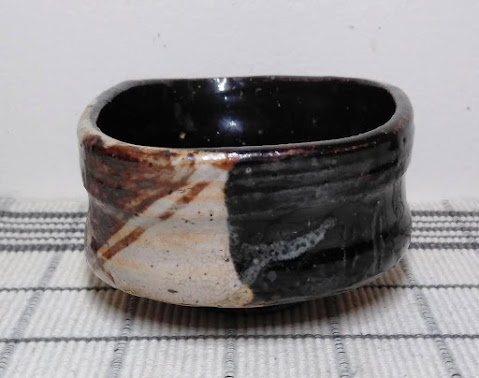229. Kutsugata kuro Oribe chawan 沓形黒織部茶碗 (clog-shaped black Oribe teabowl)
Gray clay; glazed in black and cream with added decorations in brown; foot ring and base left unglazed. Weight: 398 g (14 oz). Width of rim: 14 x 11 cm (5-1/2 x 4-3/8 in); of foot ring: 5.4 x 5.2 cm (2-3/16 x 2 in). Height. 6.6 cm (2-5/8 in).
This is a kutsugata, or “clog-shaped” teabowl. It sits on the foot ring, which is an irregular oval, about 0.5 cm (1/4 in) high on the exterior; the interior of the foot ring was hollowed out to slightly less than this depth. Above the foot ring, the bottom rises at a shallow angle to the junction with the vertical walls, which begin 1.7 cm (5/8 in) above the base. An artist’s mark was inscribed on the bottom. There could be characters inscribed within the foot ring, but that may just be my eye trying to find patterns in the scratches. The bottom dimensions of the sides are slightly narrower than the rim but generally mirror the shape of the rim. There is a horizontal groove a finger’s width wide running around the piece, centered just below the midpoint of the walls. Below this the walls are shaped in a shallow convex arc; above it, the walls swell gently outward to the rim in a straightish line. The walls have many horizontal lines running around the piece. The rim is rounded. The interior follows the contours of the exterior but is much smoother. Overall the surface is quite smooth, including the unglazed sections. The clay looks coarse, but it is actually fine-grained. The base is pitted but otherwise smooth to the touch.
The foot ring and most of the base were left unglazed. The outer edges of the base have some spillover black glaze on one side. The interior and most of the exterior were coated in a thick black glaze. Two sections of the walls were covered in a cream glaze (probably put on before the black glaze was applied). Portions of the cream glaze have a rosy orange tint, somewhat like the effects found with the Shino glaze. A brown glaze was used to draw patterns in the cream areas.
This came in an old wooden box, inscribed in two lines. The line on the right reads: 沓形 (kutsugata, or “clog-shaped”; the line on the left: 黒織部茶碗 (kuro Oribe chawan, or “black Oribe teabowl”).
The seller dated this piece to the Meiji era.
Purchased
from Treasures of Old Times), Bangcock, Thailand, September 2023.













No comments:
Post a Comment